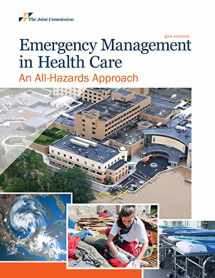
Emergency Management in Health Care, 4th Edition (Soft Cover)
Book details
Summary
Description
Emergency Management in Health Care: An All-Hazards Approach, 4th Edition, is a critical resource for organizations to identify emergency planning needs and to develop an effective level of preparedness to address a range of emergencies. This book targets new emergency managers and others involved in planning and implementing an organization s emergency operations plan (EOP) or emergency management plan (EMP) and offers guidance and best practices shaped by Joint Commission s Emergency Management (EM) standards. This new edition contains a comprehensive description of enhanced emergency preparedness requirements under the US Centers for Medicare & Medicaid Services (CMS) final rule for Emergency Preparedness Requirements for Medicare and Medicaid Participating Providers and Suppliers. The new CMS requirements apply to all 17 provider and supplier types, and compliance is required for participation in Medicare. Readers will also benefit from nearly a dozen newly developed case highlights featuring actual health care organizations. Each one shares lessons learned from emergency management planning activities or actual emergency responses to incidents such as mass shootings to active shooters to natural disasters. Also new in the fourth edition are downloadable, adaptable tools for emergency management planning, response, and recovery. The goals of the Emergency Management in Health Care revision are to do the following: Emphasize the role of leadership in emergency planning and response Help organizations adapt to singular or escalating threats such as infectious disease outbreaks, acts of terrorism, active shooters, industrial accidents, unusual weather occurrences, and other emergencies Expose the vulnerabilities that may impact technology in disaster responses such as failures to manage resources, utilities, and systems processes and technology advancements that may increase security surrounding the use of electronic medical records Provide accurate and current information about Joint Commission and federal EM requirements Key Topics: Developing the framework for preparedness, including the Hazard Vulnerability Analysis and the four phases of emergency management Implementing the emergency operations plan Addressing the six critical areas of emergency response (communication, resources and assets, safety and security, staff responsibilities, utilities management, and patient clinical and support activities) Planning testing and evaluation activities Recovering after an incident Key Features: In addition to downloadable and adaptable tools, some repeating chapter features in Emergency Management in Health Care include the following: Standards Focus Identifies the concepts from the Joint Commission standards that are addressed in the chapter Standards FAQ Shows the most frequently asked questions about emergency management standards Define Your Terms Provides precise definitions of key words and phrases Community Collaboration Highlights collaborative relationships and support structures for health care organizations Setting Spotlight Provides tools, tips, and resources for ambulatory health care, home care, nursing care centers, behavioral health care, and laboratory settings Vulnerable Populations Identifies populations requiring special consideration in planning activities Capacity Builder Provides additional resources, checklists, tools, and links that can help in emergency planning and preparedness Threat Analysis Identifies challenges to emergency preparedness concepts Case in Point Shares lessons learned and actions applied in actual health care organizations Key Audience: Emergency managers Safety managers and officers Security chiefs Facilities managers Clinical and administrative leaders Staff educators


We would LOVE it if you could help us and other readers by reviewing the book
Book review



